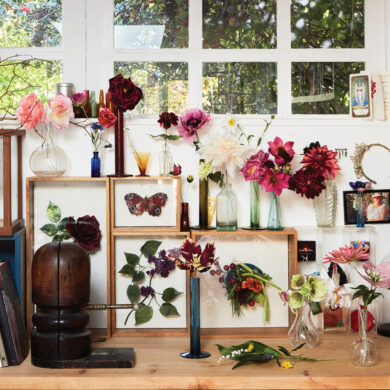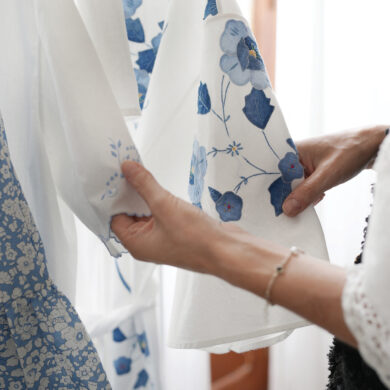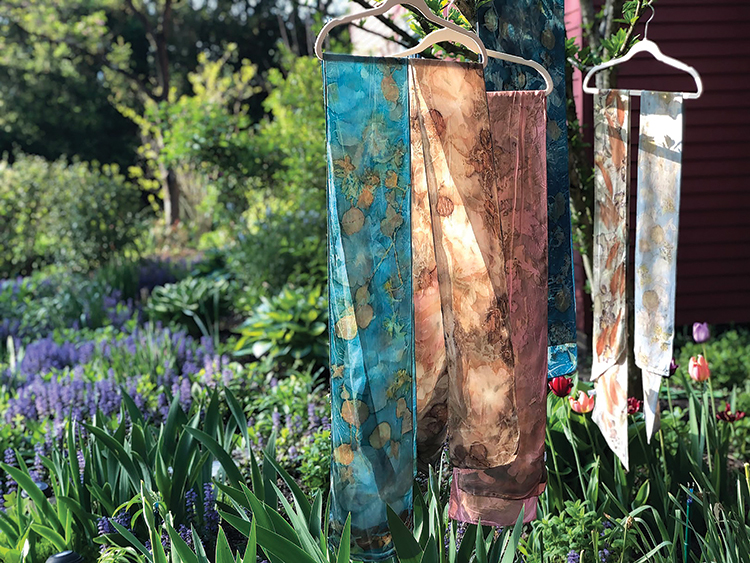
My botanical arts line was birthed in 2006, first with mixed media botanical collages, which I create using handmade and painted papers with botanical specimens that I collect, press, preserve and enhance— all using a uniquely developed 10-step process. A few years later, a line of botanical collage jewelry incorporating the color and intentional design captured in my framed artwork was born. My most recent botanical art endeavor has been a deep dive into the world of ecoprinting.
During the ecoprint process, botanicals (mostly leaves and flowers) transfer their dyes to natural fibers that have been specially prepared with elements such as aluminum and iron during a mordanting process. This assists in the transfer and retaining of the botanical dyes and allows them to become “fixed” onto the fiber. The imprint is developed when a tight bundle is created by rolling the botanicals into the fibers. Some botanicals will instead leave a negative imprint, or resist, either due to fugitive natural dyes in the plant, or based upon which side of a leaf is pressed against the fabric. Finally, the bundles are steamed for a few hours, during which time the heat sets the transfer.
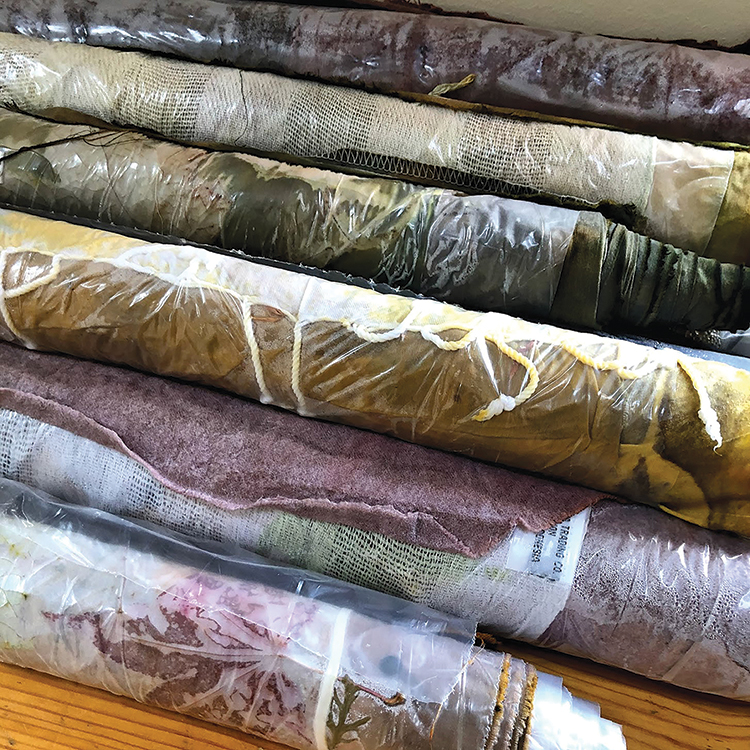
Each piece is entirely one of a kind and can never be repeated (for better or for worse!). I often feel like an alchemist aspiring to find the “botanical gold” unrolled in the steamed bundles. It’s truly a mix of science and art, which, actually, describes many of the pursuits in my life. Although I’ve had to learn a new skill set (mordants), I had the botanical part down already, as I had studied botany and biology while pursuing my master’s degree in horticulture. I also have a sixth sense regarding which plants might lend themselves to a strong imprint— though the scientist part of me likes to catalog the imprint created by many of the species growing in my garden. Keeping a journal has always been important for me, as I’m most often making 20–30 pieces per print session, which from start to finish can take me about 2 weeks to complete. Thinking I’ll remember how I prepared the first textile after 2 weeks is wishful thinking without detailed notes. There are so many factors at play, some of which can be planned for while others are entirely beyond calculation.
One of my favorite plant combinations that creates reliable soft greens, greys, light blues and silvers from the interplay of the chlorophyll, tannins, iron (and whatever other ju-ju happens when all rolled together and steamed) is to use only fresh, green ferns. I typically add about 3–5 different fern species that all grow wild or cultivated in our gardens. Some of my other favorite printing plants are Alchemilla, Baptisia, Nandina, Acer, and Ginkgo—most of my pieces contain all or some of these species. I suppose they are my botanical signature. I collect the majority of the botanicals I use for any of my mediums from our gardens, which I keep well stocked with my favorites for pressing and printing. Any of our five adopted dogs may be my companion when I’m out cutting from the garden or foraging for wild plants.
Laying out the botanicals on the textiles is the easiest part. The bulk of the process is about preparation. The fabrics must be scoured (washed in very hot water) with detergents strong enough to remove any residues from manufacturing that can impede an effective print. Then, depending upon the types of dyes that I plan to use, I typically mordant my fabrics, though sometimes, I skip the pre-mordanting and use only vinegar and iron. Although I find that I get better results when using plastics to line the fabric in the bundle, with a little extra planning and care, I can reuse them indefinitely. Along with washing and reusing all of my carrier blankets and composting all of the spent plant materials, I’ve gotten the process down to almost zero waste.
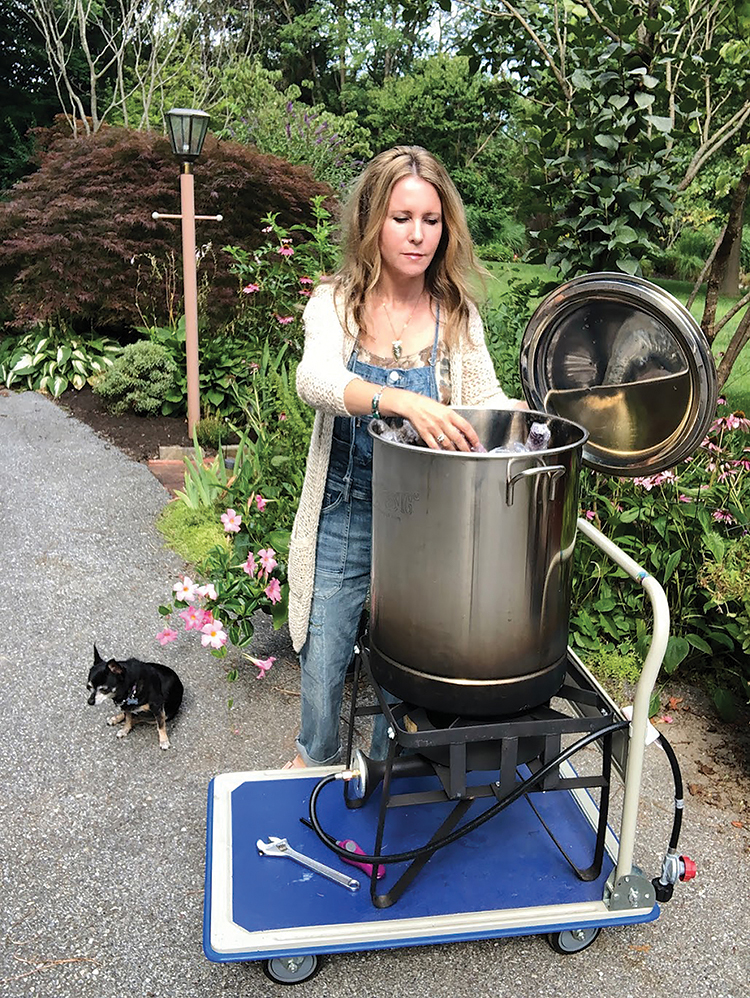
Once the ecoprinted textiles are unwrapped and washed, I hang them to air dry from the grape arbors in the back of the studio. Then, they are ironed, labeled, styled on the mannequin if selling online, and photographed. As anyone that sells online knows, photography is a necessary but somewhat laborious process, but I insist on having fun with it. I like to take my “Quinn” outdoors when the weather is nice. Scarves are the most popular item I sell, but I also print some clothing and other accessories.
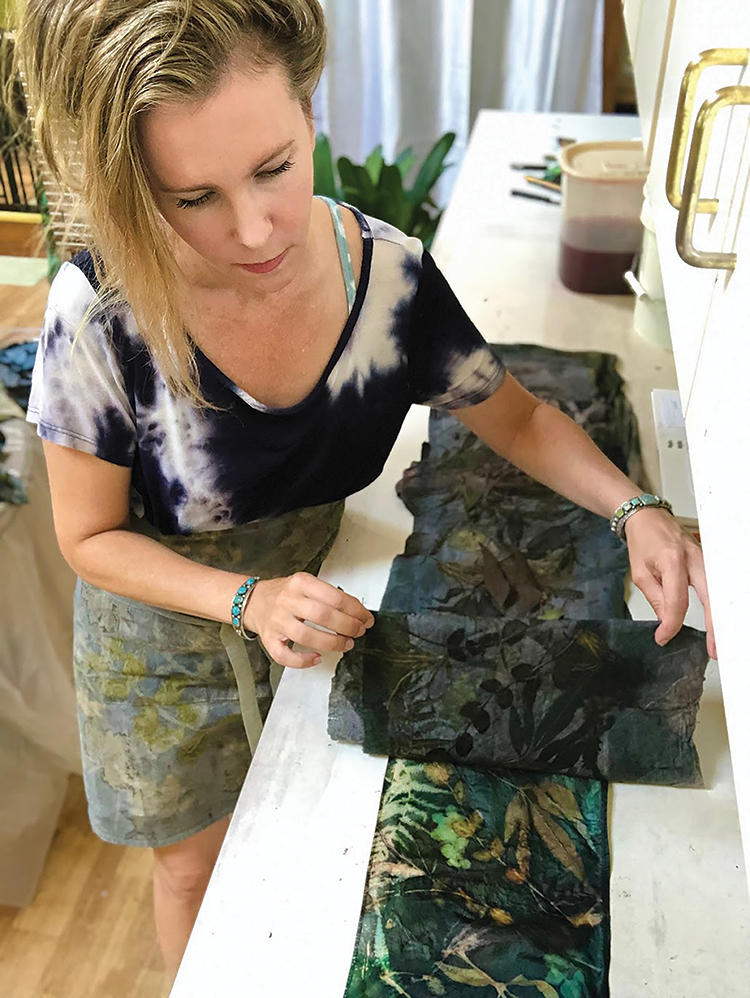
I always strive to maximize color preservation in any of my botanical pursuits and have no shame in embellishing where needed. An ecoprinted textile that’s a little too “sad” can pop back to life with a dash of turquoise, gold or purple. While I love when a textile turns out perfectly, I also love a challenge and few things bring me more joy than when a little wabi sabi transforms an “eh” into a “wow!” Even my ecoprints are mixed media as I often incorporate stencils or resists, and some wind up being more like a painting in the end. Since I am an admitted color addict, I don’t limit my work to only botanical dyes, though my favorite botanical dyes to use are logwood, indigo, and weld. When using synthetic dyes, ecoprinting is often referred to as “medium printing”. Along with color, I’m always looking for a visual motif that anchors a piece with repetition and movement.
I’m most inspired by the designs and color palettes that Gaia herself creates. For this reason, I get a lot of inspiration from traveling. Whether it’s the soft pastels of a sunrise over the Pacific Ocean, or the verdant greens of a forest in Ireland, truth be told, I can find inspiration anywhere, I’ve created designs from color palettes based upon Persian rugs, classical paintings, and even my favorite garden bed in the autumn.
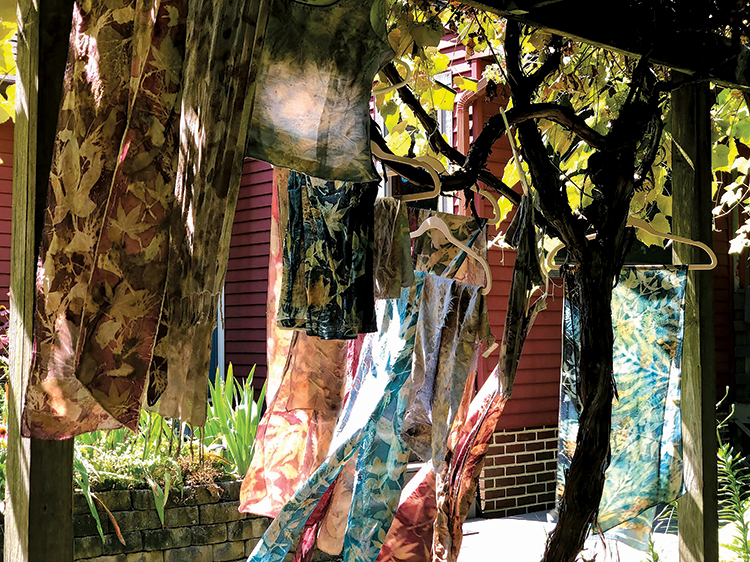
Art of Business
A true DIY, dabbler and maker by nature, I began my artisan career after enough requests from friends and family to “make them something morphed into selling my botanical collages at juried regional art shows and local shops. Eventually, after learning to replicate my designs, while still creating one-of-a-kind pieces, I entered the wholesale market; this provided me with time in my studio and afforded me a break from schlepping my stuff around to art shows.I had left a career in horticulture to get out of the heat, rain and snow, and reclaim my botanical pursuits on my own schedule (i.e., when the weather is nice!), but even as an artist, I still found myself setting up booths in sweltering heat and suffering through sleepless nights worried about strong winds and flash floods. Moving to a more predictable and indoor sales venue that the tradeshows for wholesale markets provided was a welcome change, for a time.Around 2019, after some realizations about the amount of time I was spending doing things I didn’t really enjoy, like packing up boxes of fragile artwork to ship across the country while performing special prayers to the winged courier gods (i.e., FedEx) that my work would arrive in one piece, I felt the urge for another transition. I started daydreaming about easy-to-ship, lightweight mediums I could pursue—the appeal of fiber arts grew more and more.
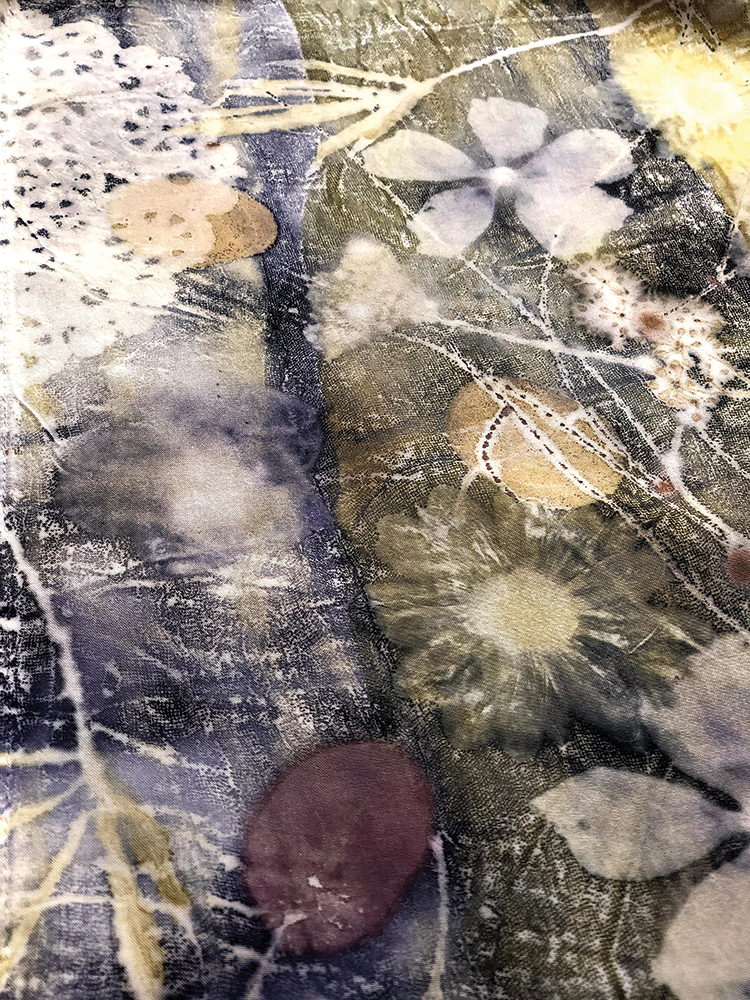
Writing about it now, I’m laughing about how anxiety about weather and my lack of enthusiasm for complex shipping problems have served as the impetus for some course corrections, but I know that rarely can we get a sense of how we’d like to be spending our time without experiencing the opposite. I still have a dozen or so retailers that I stock, as I worked hard to build these relationships, but I have let go of the rest. I also like to have work available for my now limited “mobile boutique” events and for local shops and galleries that carry my work.
My latest love affair is with my Etsy shop—even though I had been selling directly from my website shopping cart for many years, I only recently opened my Etsy shop after the realization that I needed more exposure after a decade of primarily selling wholesale, and I had been slow to get on (and stay on) the social media bandwagon. Without being willing to change things up, I would have never found out that a solid portion of my online sales are to Europe.
At the end of the day, I actually “have to” sell my work because I would have no idea what to do with how much I produce—call it the blessing and the curse of the maker. I’ve made many thousands of pieces over the years. I rarely stop to think about that because for me it’s very instinctive; creating is almost like breathing. It’s involuntary and well, we know what happens when we stop breathing. Besides, “Beauty without expression is boring,” as Ralph Waldo Emerson summarizes so succinctly.
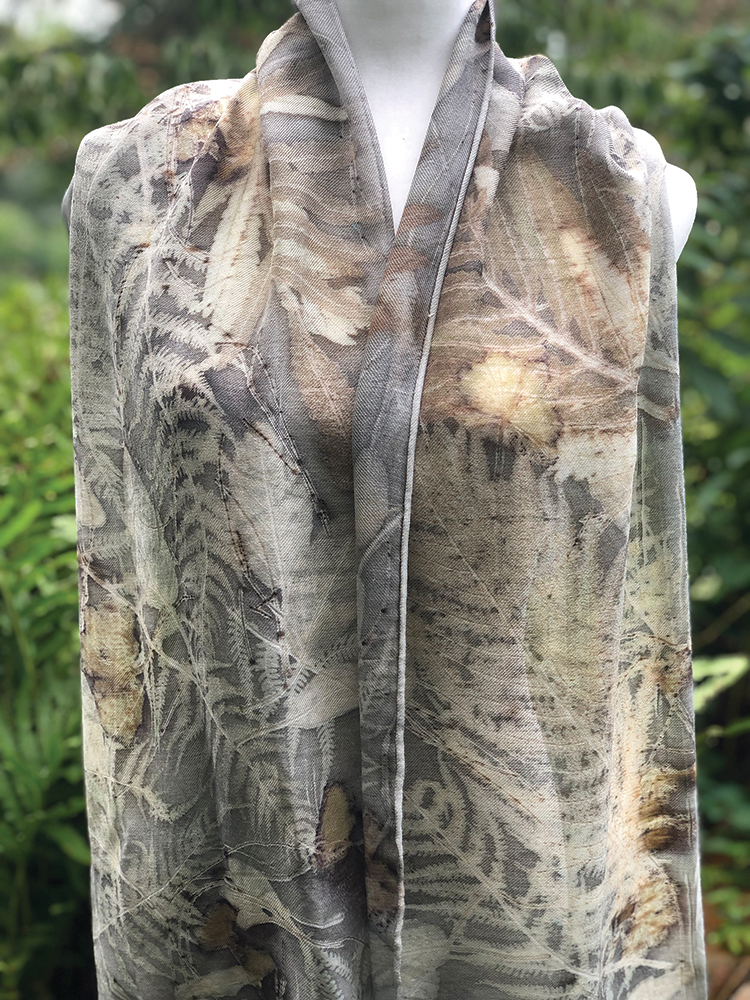
With no formalized education in art, I’ve had a bit of a learning curve in terms of materials and techniques to learn about, but one of my favorite pursuits is to take art classes. I can see myself teaching any number of botanical arts/crafts (hopefully in exotic locations), but I’m not quite there yet. For now, I’m still enjoying being a student and there are still more mediums to explore. At times I flirt with the idea of opening my own brick and mortar shop and daydream about the other artists whose work I would love to carry in it, but it’s no small commitment, and I enjoy the flexibility inherent in my current operation.
If past history is any indication of the future, I know that there will likely be a time when I’ll want to move the goalposts again, and as old doors close, new doors will open. As Joseph Campbell relates, “When you follow your bliss… doors will open where you would not have thought there would be doors, and where there wouldn’t be a door for anyone else.” This couldn’t be more true about my life, its past trajectory and more than likely its future. As I follow my bliss, I simply strive to get out of my own way, create balance in anything that I’m pursuing at any given time, and always, always, make the most of my one precious life.

My botanical arts line was birthed in 2006, first with mixed media botanical collages, which I create using handmade and painted papers with botanical specimens that I collect, press, preserve and enhance— all using a uniquely developed 10-step process. A few years later, a line of botanical collage jewelry incorporating the color and intentional design captured in my framed artwork was born. My most recent botanical art endeavor has been a deep dive into the world of ecoprinting.
During the ecoprint process, botanicals (mostly leaves and flowers) transfer their dyes to natural fibers that have been specially prepared with elements such as aluminum and iron during a mordanting process. This assists in the transfer and retaining of the botanical dyes and allows them to become “fixed” onto the fiber. The imprint is developed when a tight bundle is created by rolling the botanicals into the fibers. Some botanicals will instead leave a negative imprint, or resist, either due to fugitive natural dyes in the plant, or based upon which side of a leaf is pressed against the fabric. Finally, the bundles are steamed for a few hours, during which time the heat sets the transfer.

Each piece is entirely one of a kind and can never be repeated (for better or for worse!). I often feel like an alchemist aspiring to find the “botanical gold” unrolled in the steamed bundles. It’s truly a mix of science and art, which, actually, describes many of the pursuits in my life. Although I’ve had to learn a new skill set (mordants), I had the botanical part down already, as I had studied botany and biology while pursuing my master’s degree in horticulture. I also have a sixth sense regarding which plants might lend themselves to a strong imprint— though the scientist part of me likes to catalog the imprint created by many of the species growing in my garden. Keeping a journal has always been important for me, as I’m most often making 20–30 pieces per print session, which from start to finish can take me about 2 weeks to complete. Thinking I’ll remember how I prepared the first textile after 2 weeks is wishful thinking without detailed notes. There are so many factors at play, some of which can be planned for while others are entirely beyond calculation.
One of my favorite plant combinations that creates reliable soft greens, greys, light blues and silvers from the interplay of the chlorophyll, tannins, iron (and whatever other ju-ju happens when all rolled together and steamed) is to use only fresh, green ferns. I typically add about 3–5 different fern species that all grow wild or cultivated in our gardens. Some of my other favorite printing plants are Alchemilla, Baptisia, Nandina, Acer, and Ginkgo—most of my pieces contain all or some of these species. I suppose they are my botanical signature. I collect the majority of the botanicals I use for any of my mediums from our gardens, which I keep well stocked with my favorites for pressing and printing. Any of our five adopted dogs may be my companion when I’m out cutting from the garden or foraging for wild plants.
Laying out the botanicals on the textiles is the easiest part. The bulk of the process is about preparation. The fabrics must be scoured (washed in very hot water) with detergents strong enough to remove any residues from manufacturing that can impede an effective print. Then, depending upon the types of dyes that I plan to use, I typically mordant my fabrics, though sometimes, I skip the pre-mordanting and use only vinegar and iron. Although I find that I get better results when using plastics to line the fabric in the bundle, with a little extra planning and care, I can reuse them indefinitely. Along with washing and reusing all of my carrier blankets and composting all of the spent plant materials, I’ve gotten the process down to almost zero waste.

Once the ecoprinted textiles are unwrapped and washed, I hang them to air dry from the grape arbors in the back of the studio. Then, they are ironed, labeled, styled on the mannequin if selling online, and photographed. As anyone that sells online knows, photography is a necessary but somewhat laborious process, but I insist on having fun with it. I like to take my “Quinn” outdoors when the weather is nice. Scarves are the most popular item I sell, but I also print some clothing and other accessories.

I always strive to maximize color preservation in any of my botanical pursuits and have no shame in embellishing where needed. An ecoprinted textile that’s a little too “sad” can pop back to life with a dash of turquoise, gold or purple. While I love when a textile turns out perfectly, I also love a challenge and few things bring me more joy than when a little wabi sabi transforms an “eh” into a “wow!” Even my ecoprints are mixed media as I often incorporate stencils or resists, and some wind up being more like a painting in the end. Since I am an admitted color addict, I don’t limit my work to only botanical dyes, though my favorite botanical dyes to use are logwood, indigo, and weld. When using synthetic dyes, ecoprinting is often referred to as “medium printing”. Along with color, I’m always looking for a visual motif that anchors a piece with repetition and movement.
I’m most inspired by the designs and color palettes that Gaia herself creates. For this reason, I get a lot of inspiration from traveling. Whether it’s the soft pastels of a sunrise over the Pacific Ocean, or the verdant greens of a forest in Ireland, truth be told, I can find inspiration anywhere, I’ve created designs from color palettes based upon Persian rugs, classical paintings, and even my favorite garden bed in the autumn.

Art of Business
A true DIY, dabbler and maker by nature, I began my artisan career after enough requests from friends and family to “make them something morphed into selling my botanical collages at juried regional art shows and local shops. Eventually, after learning to replicate my designs, while still creating one-of-a-kind pieces, I entered the wholesale market; this provided me with time in my studio and afforded me a break from schlepping my stuff around to art shows.I had left a career in horticulture to get out of the heat, rain and snow, and reclaim my botanical pursuits on my own schedule (i.e., when the weather is nice!), but even as an artist, I still found myself setting up booths in sweltering heat and suffering through sleepless nights worried about strong winds and flash floods. Moving to a more predictable and indoor sales venue that the tradeshows for wholesale markets provided was a welcome change, for a time.Around 2019, after some realizations about the amount of time I was spending doing things I didn’t really enjoy, like packing up boxes of fragile artwork to ship across the country while performing special prayers to the winged courier gods (i.e., FedEx) that my work would arrive in one piece, I felt the urge for another transition. I started daydreaming about easy-to-ship, lightweight mediums I could pursue—the appeal of fiber arts grew more and more.

Writing about it now, I’m laughing about how anxiety about weather and my lack of enthusiasm for complex shipping problems have served as the impetus for some course corrections, but I know that rarely can we get a sense of how we’d like to be spending our time without experiencing the opposite. I still have a dozen or so retailers that I stock, as I worked hard to build these relationships, but I have let go of the rest. I also like to have work available for my now limited “mobile boutique” events and for local shops and galleries that carry my work.
My latest love affair is with my Etsy shop—even though I had been selling directly from my website shopping cart for many years, I only recently opened my Etsy shop after the realization that I needed more exposure after a decade of primarily selling wholesale, and I had been slow to get on (and stay on) the social media bandwagon. Without being willing to change things up, I would have never found out that a solid portion of my online sales are to Europe.
At the end of the day, I actually “have to” sell my work because I would have no idea what to do with how much I produce—call it the blessing and the curse of the maker. I’ve made many thousands of pieces over the years. I rarely stop to think about that because for me it’s very instinctive; creating is almost like breathing. It’s involuntary and well, we know what happens when we stop breathing. Besides, “Beauty without expression is boring,” as Ralph Waldo Emerson summarizes so succinctly.

With no formalized education in art, I’ve had a bit of a learning curve in terms of materials and techniques to learn about, but one of my favorite pursuits is to take art classes. I can see myself teaching any number of botanical arts/crafts (hopefully in exotic locations), but I’m not quite there yet. For now, I’m still enjoying being a student and there are still more mediums to explore. At times I flirt with the idea of opening my own brick and mortar shop and daydream about the other artists whose work I would love to carry in it, but it’s no small commitment, and I enjoy the flexibility inherent in my current operation.
If past history is any indication of the future, I know that there will likely be a time when I’ll want to move the goalposts again, and as old doors close, new doors will open. As Joseph Campbell relates, “When you follow your bliss… doors will open where you would not have thought there would be doors, and where there wouldn’t be a door for anyone else.” This couldn’t be more true about my life, its past trajectory and more than likely its future. As I follow my bliss, I simply strive to get out of my own way, create balance in anything that I’m pursuing at any given time, and always, always, make the most of my one precious life.









